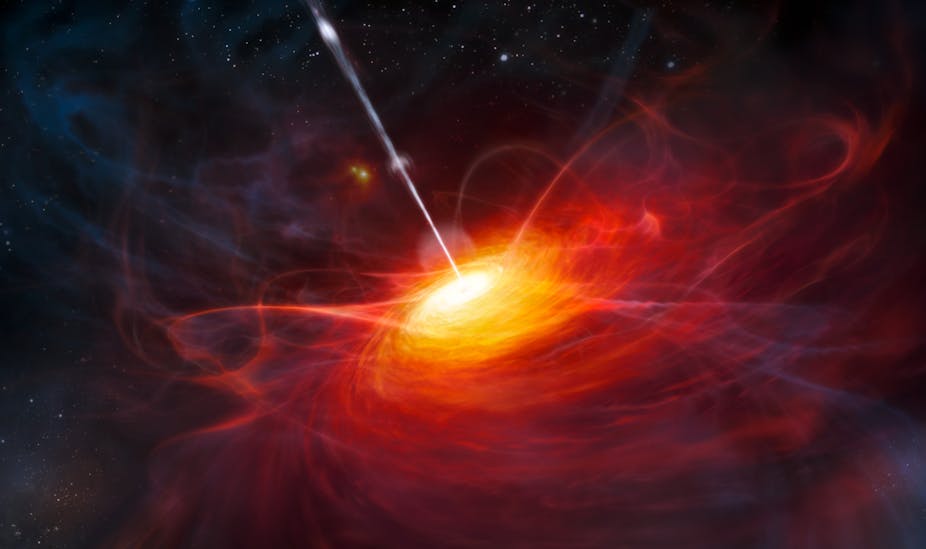Today, the University of Melbourne’s Professor Stuart Wyithe was awarded the 2011 Malcolm McIntosh Prize for Physical Scientist of the Year for his work on the origin of galaxies.
The multi-award winning physicist was described by Princeton University Observatory’s Professor Edwin Turner as “the best young scientist with whom I have ever worked in almost 35 years”.
Here, Professor Wyithe explains why the next great challenge for cosmology is discovering the origin of the universe’s billions of galaxies, and how we might go about this.
When looking at the universe from a historical perspective, astronomers are immediately faced with fundamental, unanswered questions.
We believe the universe has a finite age, and as a result, there must have been an epoch when galaxies appeared for the first time.
But we don’t know how this first generation of galaxies was formed. Nor do we know what they looked like, or how big they were. Indeed, we don’t even know when galaxies first played an important role in the evolution of our universe.
Over the last decade, the composition of the universe has been determined to high accuracy. Understanding the first galaxies represents the next great challenge for observational cosmology.
Arriving with a Bang
Currently, our knowledge of the first galaxies is limited to two primary facts, represented in the diagram below.

Astronomers believe our universe began with the Big Bang 13.7 billion years ago, after which the initially very hot universe expanded and cooled.
When the universe had cooled sufficiently, the gas of protons and electrons “recombined” to form atomic hydrogen and light was able to travel freely for the first time.
We observe this light today as a diffuse glow on the sky known as the Cosmic Microwave Background, which represents the state of the universe 380,000 years after the Big Bang.
Small ripples of density observed at this time grew under the influence of gravity, forming the sites of our modern-day galaxies. Nuclear fusion lit up the universe as hydrogen atoms clumped to form stars and galaxies.
Some of the atomic hydrogen in the early universe formed stars within galaxies, but most is located in the space between galaxies.
The current belief is that the first galaxies appeared a few hundred million years after the Big Bang, and bathed the universe in ultra-violet starlight. This starlight split inter-galactic hydrogen into its constituent protons and electrons, and heated the universe by 10,000 degrees in a process known to astronomers as reionisation.

Astronomers refer to this reionisation period, during which the gas in the universe went from being almost completely atomic to almost completely ionised, as the end of the Dark Ages of the universe.
Putting the pieces together
Reionisation was an important milestone in the history of the universe for two reasons.
1) Reionisation identifies the time when stars and galaxies became the dominant influence on the conditions in the universe.
2) The study of reionisation provides an opportunity to study the properties of the first galaxies and stars.
Because the temperature of the universe plays a significant role in galaxy formation for all subsequent galaxy evolution, reionisation must be understood as part of a complete theory of galaxy formation.
What next?
There are several key areas in which substantial progress will be made in the study of the first galaxies during the coming decade.
The first involves forthcoming programs, with an emphasis on obtaining data beyond the current redshift, or distance frontier, using new surveys and instruments.

Following the success of the Hubble Space Telescope, NASA’s flagship James Webb Space Telescope (JWST) is scheduled for launch in 2014. JWST is a large infrared-optimised telescope that will be used to search for the distan or high redshift galaxies thought to be responsible for the reionisation of the intergalactic hydrogen.
The advent of 30-metre class telescopes in the next decade, such as the Giant Magellan Telescope, will open a new window on the universe allowing spectra to be taken of the earliest forming galaxies discovered with JWST.
Radio telescopes such as the Murchison Widefield Array (now beginning to take data in Western Australia), will lead efforts in this exciting new field. Next generation ground-based surveys such as the ANU-led SkyMapper, will discover high redshift quasars.
Finally, the Planck surveyor Cosmic Microwave Background experiment will provide tighter limits on fundamental cosmological and astrophysical parameters, providing better constraints on the history of the intergallactic medium, the gas that extends between the galaxies.
The goal of these observations will be to trace the physical history and origin of the first galaxies, which can only be achieved within a sophisticated physical framework.
Such work will underpin our quest to understand the first galaxies.

